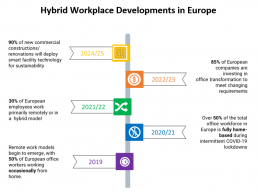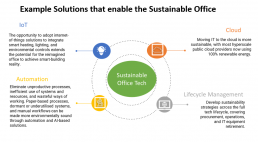New Work Models Drive Investments in Office Transformation for Future of Work
In the space of less than two years, remote working has become commonplace for millions of Europeans. According to IDC survey data, pre-pandemic around half of Europeans were working occasionally from home. As of March 2022, according to IDC data, in countries like the UK, one third of employees report having their primary workplace away from the corporate office.
Acknowledging the need for more adaptable business models, most European enterprises will give employees more job autonomy by granting increased flexibility regarding work location. Our December 2021 Enterprise Resiliency survey found that over a third of European businesses expect remote and hybrid work to become accepted practices. In fact, several Western European countries such as Germany, France and Portugal now have laws in place that make it mandatory for employers to offer staff the opportunity to work from home if there are “no compelling operational reasons for not doing so”.
The events of 2020 triggered a global shift in working models and attitudes towards office working. As a result, IDC expects that by 2025, daily office occupancy across Europe will be a third lower than in 2019. The role of the office will change to more of a collaborative and creative space, with employees splitting their working week between their home and the office. IDC research clearly shows that because of this changing work model, organisations have a renewed appetite to invest in the workplace, aiming to create attractive, collaborative spaces that make it worth commuting to the office (at least occasionally). To enable this change in working models, 85% of European businesses say they are making changes to their physical work environment, with about half retrofitting existing spaces and the other half investing in entirely new facilities.
Sustainability is an integral part of planning for these new, more appealing office structures. The trend is cutting across all industries and is primarily based on the need to adhere to increasingly stringent global sustainability requirements. Importantly though, it is not solely driven by legislators but also by other key stakeholders, such as employees and customers, demanding socially equitable, environmentally responsible, and economically viable offices. With employers viewing the office as a place for collaboration and meaningful employee connection, the role of the workplace is shifting towards a more intentional work setting defined by its ability to bring people and teams together.
Re-imagine the Office of the Future to be Sustainable
Re-imagining the workplace is a once in a generation chance to introduce next-level environmental, social, and governance (ESG) metrics, reduce carbon footprints, and at the same time demonstrate true operational value. Our research has shown that primary motivations driving office transformation include improving operational and financial performance, finding competitive differentiation, generating a positive impact on society, and complying with tightening regulatory and investor requirements.
Offices need to become spaces employees choose to come to. A sustainable office environment should put people first while being automated and smart, reducing energy consumption, enhancing efficiency, saving costs, and enabling proactive maintenance. State-of-the-art technologies can support both business and worker objectives, which in practice mostly overlap; for example, aiming for a safe and enjoyable work environment that drives productivity.
IDC predicts that by 2025, 90% of new commercial constructions/renovations will deploy smart facility technology supporting flexible workplaces and sustainably improving occupant experiences and operational performance. The concept of a smart building is driven by the convergence of IT and the increasing usage of analytics and actionable data. Instrumented smart facilities will become the new baseline expectation. Possible solutions applied in a smart office could include (among others) a full shift to public cloud, automated tech lifecycle management, IoT sensors collecting real-time data (i.e., temperature, occupancy, air quality, or energy consumption), and AI-based analytics software used to predict and optimise facilities, processes, and occupant experiences.
Business Leaders Should Consider Office Sustainability as a Time-Sensitive “Act-Now” Opportunity
A crisis is often the catalyst for change, creating opportunities to gain new perspectives. Remote work practices have been on the cards for some for several years but, as with so many other things, the global pandemic has significantly accelerated the trend to more flexible work models. For the aforementioned 85% of European businesses that plan to make changes to their physical work environment to accommodate new hybrid working practices, there is an opportunity to not just be ahead of the curve in terms of complying with upcoming stricter environmental regulations, but also to impress staff, investors, and customers alike with out-of-the-box solutions for a more sustainable office environment.
Designing a sustainable office that can be truly part of a green economy is one of the greatest opportunities for businesses. Increasingly, a sustainable workplace is becoming an essential rather than just a nice to have. Coming out of the pandemic, companies are now being viewed not just by how they treat their employees and customers, but by their impact on the world. Owning a “green office” will increasingly be considered a significant competitive advantage.
Global regulations are supporting the adoption of sustainable business practices. As early as 2017, the French government enacted new regulations requiring that French multinational companies identify and prevent adverse sustainability impacts resulting from their own activities and the activities of their subcontractors or suppliers. Global organisations such as the World Bank Group urge governments to adopt COVID-19 stimulus packages that will promote sustainable growth.
Governments are a driving force behind the trend toward more sustainable office design. Paving the way for a greener and more resilient future after the pandemic, the European Union approved the Next-Generation EU, a temporary recovery fund totalling €750 billion to support the efforts of member states. A minimum of 37% of the funds need to be dedicated to climate-related solutions, and 20% to projects facilitating digital transition — both initiatives are closely linked to the “reimagined” sustainable office.
Growing worker activism is also pushing employers toward sustainability. Workers are emerging as a newly empowered and vocal group with the ability to materially influence a company’s strategy and reputation. Companies that fail to meet employee expectations on sustainability may see talent shortages or problems with engagement.
As part of the greater story on sustainability, positive changes in new office designs are an opportunity to make an organisation more agile and, ultimately, more profitable through a deep-seated change in mindset. If nothing else, the next generation of workers will be dominated by young people for whom ecological consciousness has become a cultural, creative and value driven endeavour. It is this demographic who will be increasingly, and inexorably, demanding wholesale change in the way their place of work is designed and organised.
What Next?
Office sustainability is not just about what must be done to protect the environment, but needs to have business considerations. Consumer sentiment demands brands to be green. Organisations should balance the needs of people, the planet, and the company’s profits to create long-term customer and shareholder value. A well-managed and implemented office transformation (as part of a wider ESG program) will lead to the following business outcomes:
- Organisations with successful sustainable office programs create greater brand affinity/loyalty with current employees. Employee engagement around an ethical cause increases job satisfaction and wellbeing.
- Organisations with a more a progressive approach to sustainability are more attractive for future employees and customers.
- Organisations with effective ESG programs will be able to draw additional investors and capital.
As part of their overall transformation journey, businesses willing to make sustainability in their office makeover a priority must embrace three key principles:
- Confident leadership. Lead with a bold vision that aligns overall business model with a unique approach to the creation of a sustainable office.
- Viable execution. Drive action by integrating office sustainability into all layers concerning the reimagined office, including external stakeholders, such as suppliers and partners.
- Embrace open communication and align internal and external stakeholders by delivering on the company’s pledge for a sustainable office within a manageable timeframe.
Considering the changing rhythms of where, when, and how work happens, the sustainable office will be viewed as an integral part of becoming an agile business. Like digital transformation before it, office sustainability cannot be just added on as an afterthought, or a “nice-to-have”. Instead, over the coming years, holistic sustainability is sure to become a top priority for business leaders, and re-imaging the sustainable office is a definite starting point that will result in measurable positive business outcomes.
To learn more about our upcoming research, please contact Meike Echerich, or head over to https://www.idc.com/eu and drop your details in the form on the top right.




